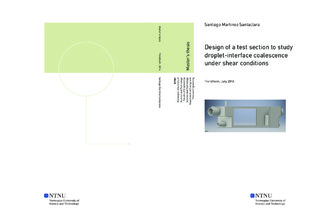| dc.description.abstract | Separation is a vital process in oil industries, where the mixtures separation, like the upstream gotten from oil reservoirs, differentiate the useful products. Gas-liquid separation process has been widely studied in order to optimize the quality of gas to export and later refine. However liquid-liquid separation has not been as optimized as gas-liquid separation. Nowadays liquid-liquid separators consist in a big over- dimensioned vessels, where due to the slow migration velocities and the coalescence time liquids get separate after some time. Specially in the offshore installations where space and weight play a crucial role in the design and transport of the mate- rials is not so easy, this over-dimension of the containers can create overweight and structural issues.
In this thesis the different parts of the separation process (dynamics of droplets, and their interaction with a liquid-liquid interface) have been studied. In order to be able to conceive, design and build a facility which can simulate the processes suffered by the liquids during the separation, an extensive work in literature has been reviewed.
The goal of this work is starting from a simple circuit, design and build a test section which will allow to simulate and study the coalescence process and the droplet dynamics inside a gravity separator inducing shear by forcing flows to run in opposite directions in the presence of the other. The design was performed with 3D software and built in transparent resin in a 3D printer. A study of transparency through different post-printing processes and section designs with the addition of crystal slides is presented. Also resistance of sections built and supports generated in a 3D printer has been performed to validate this method for experiments in the future.
The facility construction suffered modifications from the first idea due to a lack of time to perform all the components although they are included both in theory and designing part. Visualization of the droplets was achieved with a high-speed camera over a film rail controlled by computer software. The results show the validation of the 3D prints for possible laboratory uses as the pieces are able to resist increases and reductions of flow without suffering an important pressure drop. Because of the superposition of resin layers and the aging of the resin film through the resin was rejected. A re-design of the test section was made to incorporate windows to be able to visualize and illuminate the simulation of the gravity separation process. | |

